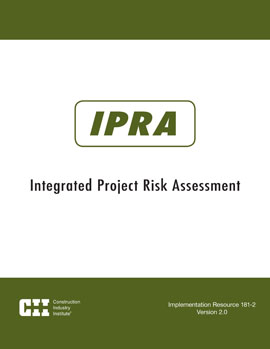
Integrated Project Risk Assessment (IPRA), Version 2.0
Risk has different meanings to different people, and the concept of risk varies according to viewpoint, attitude, and experience. Engineers, designers, and contractors often view risk from a technical perspective, while owners and developers tend to view it from the economic and financial side. Similarly, safety and health professionals take a more hazard impact/mitigation perspective. Some see risk as an abstract concept and, therefore, as something that is difficult to measure. Thus, gaining alignment in terms of how to approach risk on a project is not easy; however, it is essential.
| The Integrated Project Risk Assessment (IPRA) is an effective tool for assessing the degree of risk on any project, but it is especially useful for complex projects in unfamiliar venues or localities. |
Risk assessment and risk management are critical tasks for construction projects, yet owners and contractors have few evaluation tools or guidelines to help them with these processes. Management of risk is especially important when an organization is considering a complex project that is to be constructed in a jurisdiction with unique challenges. The Integrated Project Risk Assessment (IPRA) tool was initially developed by the Construction Industry Institute’s (CII) Risk Assessment for International Projects Project Team, and subsequently updated by CII’s Risk Management Integration Team. The IPRA identifies and describes the issues critical to complex capital projects performed in unfamiliar jurisdictions; it allows project teams to focus on risk factors of potential concern. The IPRA is intended to help teams evaluate their risk exposure, and it provides an indication of the potential impact of risk during the full project life cycle. In effect, it can serve as an “aide memoire” for the project participants. While risk control and mitigation were not within the scope of the initial research mandate, the IPRA has proven to be effective at indicating which project components should be considered for risk mitigation in the context of an overall risk management strategy.
When the IPRA was initially developed it was focused on international projects that were defined at the time as projects performed by North American investors, owners, and/or contractors, and located outside of North America. Originally titled International Project Risk Assessment, the tool is now called Integrated Project Risk Assessmentbecause in the intervening years CII found that it is applicable to and effective for a wider variety of projects. The Risk Management Integration Team found that the document’s title and write-up limited its adoption and was not indicative of actual practice. Moreover, it was apparent that the tool could be used for more than just risk assessment, and could be a cornerstone of an effective risk management process as outlined later in this document. To address these issues, the team produced this new edition.
RT-181’s research (case studies, interviews, surveys) showed that assessing risk was a project management activity to be done throughout the project life cycle. This is key to effectively managing the risks. The relative importance of any specific risk depends on the respective stakeholders, and could be different for different stakeholders. Therefore it is essential to get a broad range of perspectives when assessing risk in order to arrive at a consensus on relative importance of risks (IR181-2, p. 22).
IR181-2, Integrated Project Risk Assessment (IPRA)
The International Project Risk Assessment (IPRA) tool focuses on the risks typically encountered during the life cycle of international capital projects.


